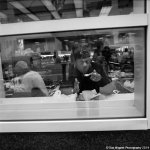NY_Dan
Well-known
For me, one of the most valuable concepts in street photography is the ten-foot shot. Weegee mentions this in his writings. In his case, ten feet was useful for a full-length photo at a known f/stop when using flash. And he, along with most press photographers used flashbulbs for shooting during both night and day. They would walk around with their Speed Graphics racked to 10 feet and their lens set to the correct stop, and their shutters cocked.
With time, these photographers instinctively knew when they were ten-feet from their subjects. I've been applying this on the streets of NYC. It's close enough to show facial expressions, yet far enough away to have a good ratio of candid shots.
And if I want to shoot a little tighter I'll set my focus to seven-feet, and to 12, 15, or 20 for wider shots. What's really worked for me lately is picking my spot and letting interesting subjects approach to 10 feet and shooting. This way I can be sure of getting a good background -- something without too much signage and that allows for separation between subject and background. With medium format, a 10-foot shot, even at f/11 can produce a desirably soft background.
I think this method is different from zone focusing, because the idea is to get a real feel for a specific distance with a specific format and focal length.
My point is that the value of simple concepts such as the ten-foot shot are easy to under appreciate. I only thought to share this because in another thread an RFF member asks about which MF camera is easiest to focus -- and it made me think that so often one doesn't need to, or have time to focus. It's really great when you're on.
Anyone else have any examples of photographic approaches/concepts that on the surface are really simple, under-appreciated, or overlooked?
With time, these photographers instinctively knew when they were ten-feet from their subjects. I've been applying this on the streets of NYC. It's close enough to show facial expressions, yet far enough away to have a good ratio of candid shots.
And if I want to shoot a little tighter I'll set my focus to seven-feet, and to 12, 15, or 20 for wider shots. What's really worked for me lately is picking my spot and letting interesting subjects approach to 10 feet and shooting. This way I can be sure of getting a good background -- something without too much signage and that allows for separation between subject and background. With medium format, a 10-foot shot, even at f/11 can produce a desirably soft background.
I think this method is different from zone focusing, because the idea is to get a real feel for a specific distance with a specific format and focal length.
My point is that the value of simple concepts such as the ten-foot shot are easy to under appreciate. I only thought to share this because in another thread an RFF member asks about which MF camera is easiest to focus -- and it made me think that so often one doesn't need to, or have time to focus. It's really great when you're on.
Anyone else have any examples of photographic approaches/concepts that on the surface are really simple, under-appreciated, or overlooked?


